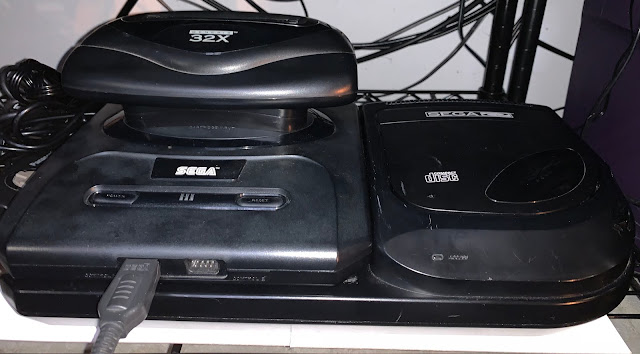A while ago I wrote about firing up my Sega CD Model 2 and finding that it did not work. Not only did it not work, but it was broken in more than one way.
To recap, first discs were making a terrible scraping noise and getting rings scratched into them.
I discovered that this was due to the shock dampers having cracked and collapsed.
 |
| Page 11 of the Service Manual courtesy of the Console5 Tech Wiki |
 |
| The dampers deteriorated with time and use. |
When the shock dampers fail like this, the CD drive sits too low and the discs will scrape the tray as it tries to spin the disc.
My first solution was to add some home-made washers to prop up the collapsed dampers. While this did work, it had two major problems. Firstly, with the CD drive rigged like this, the CD spindle was not properly level. While the magnetic clamp holds the disc in place anyway, it seemed like being off balance like that might be putting extra wear on the spindle motor.
As far as I can tell, direct replacements for these "Rubber Dampers" are no longer made. After at least a dozen hours of searching off and on I finally found a substitute part that seems to work pretty well.
Based on rough measurements of the original part this was the closest substitute I could find anywhere on the web.
One small issue with the substitute part is that the inner diameter is a single size, whereas the original damper has a larger opening on the bottom to match the two different diameters of the pike. If you try to just drop the new dampers in like the originals, the CD drive will end up riding too high. Fortunately the different dimensions of the new part mean that there's an alternative method of installation.

With all four dampers in place and pushed down, you can lower the CD drive onto the pikes, then push down. The top ring of the new dampers are small enough that they should be able to push through with a little gentle encouragement from a pair of tweezers.
 | |
|
With all six screws back in place, inspect the height of the CD drive shield. It should be raised above the disc well. There should also be a gap between the CD drive shield and the back of the disc well.
To make sure everything came out level and balanced, connect the Sega CD to a Genesis, power it on and put a disc in (you might want to test with something unimportant or easily replaceable first). Wait until you hear the drive spin up, then open the lid while the disc is spinning. If everything went well, the disc should continue spin levelly without any wobble.
The next issue I had to re-visit is the grinding noise during seek operations. Sometimes this is a momentary buzz, others it's a constant noise that won't stop until you power the unit off. This happens because the limit switch for the "home" position of the laser pickup is not correctly registering the end of travel. You'll probably find half a dozen guides online of people describing gently bending the limit switch back toward the pickup. While this did work for me, it wound up only being temporary - after a few hours it was right back to doing it again. The problem is, I believe, that the drive likes to park the laser pickup in the home position which causes it to push against the limit switch for extended periods of time. After a while the switch just bends into the shape of being pushed back.
The best solution I found was to wedge a tube of heat-shrink tubing behind the limit switch to provide a small amount of constant forward pressure.
With this fix in place the system has been working normally. Time will tell if it continues to help. A good game to test this with is Heart of the Alien - the drive always seeks to home when it goes to the continue/password entry screen.





